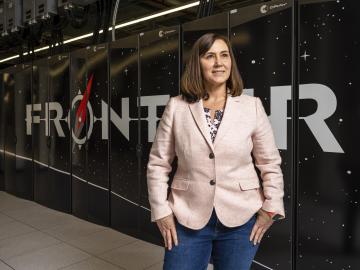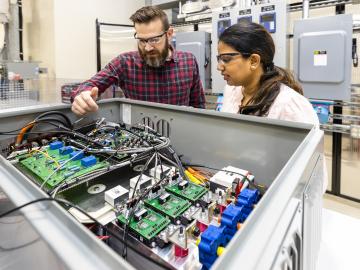
Filter News
Area of Research
- Advanced Manufacturing (1)
- Biology and Environment (9)
- Electricity and Smart Grid (2)
- Energy Science (27)
- Functional Materials for Energy (1)
- Fusion and Fission (6)
- Isotopes (2)
- Materials (33)
- Materials Characterization (1)
- Materials for Computing (8)
- Materials Under Extremes (1)
- National Security (11)
- Neutron Science (13)
- Nuclear Science and Technology (2)
- Quantum information Science (5)
- Supercomputing (41)
News Type
News Topics
- (-) Frontier (47)
- (-) Grid (35)
- (-) Materials Science (75)
- (-) Quantum Science (52)
- (-) Security (19)
- 3-D Printing/Advanced Manufacturing (73)
- Advanced Reactors (17)
- Artificial Intelligence (85)
- Big Data (49)
- Bioenergy (74)
- Biology (86)
- Biomedical (46)
- Biotechnology (25)
- Buildings (37)
- Chemical Sciences (46)
- Clean Water (16)
- Composites (15)
- Computer Science (127)
- Coronavirus (23)
- Critical Materials (6)
- Cybersecurity (20)
- Education (2)
- Emergency (3)
- Energy Storage (47)
- Environment (130)
- Exascale Computing (53)
- Fossil Energy (6)
- Fusion (47)
- High-Performance Computing (92)
- Hydropower (6)
- Irradiation (1)
- Isotopes (41)
- ITER (5)
- Machine Learning (39)
- Materials (82)
- Mathematics (8)
- Mercury (7)
- Microelectronics (3)
- Microscopy (31)
- Molten Salt (3)
- Nanotechnology (29)
- National Security (67)
- Neutron Science (95)
- Nuclear Energy (79)
- Partnerships (42)
- Physics (40)
- Polymers (14)
- Quantum Computing (37)
- Simulation (46)
- Software (1)
- Space Exploration (14)
- Statistics (2)
- Summit (42)
- Transportation (41)
Media Contacts

With the world’s first exascale supercomputer now fully open for scientific business, researchers can thank the early users who helped get the machine up to speed.

Researchers at the Department of Energy’s Oak Ridge National Laboratory are supporting the grid by improving its smallest building blocks: power modules that act as digital switches.

Tristen Mullins enjoys the hidden side of computers. As a signals processing engineer for ORNL, she tries to uncover information hidden in components used on the nation’s power grid — information that may be susceptible to cyberattacks.

To support the development of a revolutionary new open fan engine architecture for the future of flight, GE Aerospace has run simulations using the world’s fastest supercomputer capable of crunching data in excess of exascale speed, or more than a quintillion calculations per second.
For the third year in a row, the Quantum Science Center held its signature workforce development event: a comprehensive summer school for students and early-career scientists designed to facilitate conversations and hands-on activities related to

At the National Center for Computational Sciences, Ashley Barker enjoys one of the least complicated–sounding job titles at ORNL: section head of operations. But within that seemingly ordinary designation lurks a multitude of demanding roles as she oversees the complete user experience for NCCS computer systems.

As renewable sources of energy such as wind and sun power are being increasingly added to the country’s electrical grid, old-fashioned nuclear energy is also being primed for a resurgence.

Inspired by one of the mysteries of human perception, an ORNL researcher invented a new way to hide sensitive electric grid information from cyberattack: within a constantly changing color palette.

A trio of new and improved cosmological simulation codes was unveiled in a series of presentations at the annual April Meeting of the American Physical Society in Minneapolis.

Researchers at ORNL are helping modernize power management and enhance reliability in an increasingly complex electric grid.


